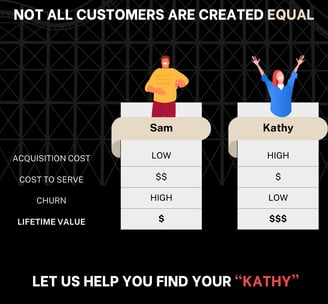Are You Focusing on the Wrong Customers? The Truth About Acquisition Costs
Not all customers are equal—some are more profitable than others. While low-cost acquisition channels may seem appealing, they can lead to high churn and lower lifetime value. This blog explores why businesses must look beyond Customer Acquisition Cost (CAC) and focus on long-term profitability by optimizing for retention, customer lifetime value (CLV), and engagement. Learn how to make smarter acquisition decisions to maximize revenue and growth. #CustomerAcquisition #CLV #Retention #MarketingStrategy


Many businesses focus on how much it costs to get a new customer, also known as Customer Acquisition Cost (CAC). If one way of getting customers is cheaper than another, it seems smart to spend more money there. But looking only at CAC doesn’t always lead to the best decision.
Getting a customer for less money today might actually cost more in the long run. If they leave quickly (high churn), don’t spend much (low lifetime value), or need a lot of help (high support costs), they might not be worth the savings. That’s why businesses need to look at the bigger picture and think about how valuable a customer will be over time.
Why Cheaper Customers Aren’t Always Better
Let’s look at an example. Brand A started using Instagram ads to get new customers. It worked! They were bringing in customers at a lower cost than using salespeople in a store. That seemed like a great deal—spend less, get more customers.
But when Profit Coaster looked deeper, there was a problem. The customers from Instagram weren’t sticking around. They were canceling faster than those who bought from a salesperson in a store. Even though the store customers cost more to get, they stayed longer and spent more. In the end, the cheaper customers weren’t actually more profitable.
What Really Makes a Customer Valuable?
Instead of just looking at CAC, businesses should think about:
1. How Much the Customer Will Spend Over Time (Lifetime Value or CLV)
A customer who costs more to acquire but stays for years is better than a cheap customer who leaves in a month.
Example: If an Instagram customer spends $1,200 over time but a store customer spends $1,900, the store customer is worth the higher cost to acquire.
2. How Long They Stay (Retention & Churn Rates)
Customers who are well-informed about a product are more likely to stick around.
A salesperson in a store can explain things better than an online ad, leading to better retention.
3. How Much More They Might Buy (Upsell Potential)
A happy, engaged customer is more likely to buy more products or upgrade to premium services.
If customers from one channel keep buying more, it justifies spending more on acquisition.
4. How Much They Cost to Support
Some customers need more help, which costs money.
A cheap-to-acquire customer who constantly needs support might be worse than a pricier customer who figures things out on their own.
How to Make Smarter Customer Acquisition Choices
1. Compare CAC to Lifetime Value (CLV)
Instead of just trying to get the lowest CAC, aim for the best CLV/CAC ratio—the most valuable customer for your money.
2. Study Customer Behavior by Acquisition Channel
Track which channels bring in customers who stay the longest and spend the most.
3. Experiment & Adjust
Test different ways of getting customers and keep an eye on long-term value, not just short-term costs.
Think Long-Term, Not Just About the First Sale
It’s easy to be tempted by lower acquisition costs, but businesses that only focus on CAC can end up losing money. The real goal isn’t just getting any customers—it’s getting profitable, long-term customers.
Smart businesses know that not all customers are the same. Let the team at ProfitCoaster help you invest in strategies that bring in loyal, high-value customers, even if it costs a little more upfront. Let’s talk!